Voronki- A Storied Kotchoubey Estate which hosted a famous rural theatre and today is the alleged final resting place of the only Decembrists buried in Ukraine

The estate Voronki / Вороньки, within the context of the Kotchoubey family first belonged to Alexandra Pavlovna Miloradovitch (née Kotchoubey) (1769-1838) through her marriage to Gregory Petrovich Miloradovitch (1765-1828). Subsequently, already years after her death, it was purchased on behalf of her grand nephew, Nikolai Arkadievitch Kotchoubey (1827-1865). In the 1850s, Arkadi Vassillievitch (1790-1878), Alexandra Pavlovna’s nephew purchased the estate most likely from her eldest son for Nikolai Arkadievitch’s before his first marriage.
Family ties…
The transfer of the estate from one family to another gives us a view into the small and almost incestuous world of little Russia (Ukraine), where families of the local nobility intermarried and were linked by blood, land and a shared history. As it turns out, the estate of Voronki was linked both by the connection between the two branches of the Kotchoubey family (Pavlovitchi and Vassilievitchi) and also through Arkadi Vassilievitch’s second cousin, Alexander Grigorievitch Miloradovitch (1793-1868) who married Sofia Grigorievna Tumanskaya (1805-1890), Arkadi Vassilievitch’s first cousin via his mother, Elena Vassilievna Kotchoubey (née Tumanskaya) (1762-1836). Elena was the sister of Grigory Vassilievitch Tumansky (1764-1811) who was Sofia’s father. According to historical records, Voronki passed to Alexander Grigorievitch but the link between the families remains.
Arkadi Vassilievitch believed in an equal and fair distribution of his assets. A belief that was shared by his siblings who amongst themselves divided their father’s estates upon his death giving equal share to brothers and sister alike. While his wife had died from cholera in 1834, when his sons Piotr Arkadievitch (1825-1892), Vassili Arkadievitch (1826-1897), & Nikoali Arkadievitch (1827-1865) begun to marry in the 1850s and having reached an age of majority he made the decision to divide the core family estates from his own inheritance and from his marriage to Sofia Nikolaevna (née Princess Wiazemskaya) (1798-1834). Much of the family’s wealth came from his marriage to Sofia Nikolaevna who was a great grand daughter of last Hetman Kyrylo Razumovsky and in turn an heiress of the Vassiltchikov lands. Among the now famous estates was Zgourovka in the province of Poltava which he left to his eldest son, Piotr Arkadievitch. Vassili who eventually settled in Yalta received other estates and as Arkadi had nothing left to pass to Nikolai, his youngest son, he bought Voronki, which was essentially already a family linked estate which for two generations was in the hands of very close relations.
It is unclear when the wooden manor house pictured above was built but it was likely in the mid-19th century. The house, a theater which was later added and the church no longer stand today.

The village and estate, are called Voronki (Вороньки – Черниговская область), which is a village name either spelled воронки or Вороньки which is frequently found across little Russia/ Ukraine and in Russia. On a more straight-forward level, the name voronki is translated into English as funnel or crater. This particular estate of Voronki is located in the southern part of the Tchernigov province and it is found a few hours drive to the north west of Kiev -65 km (today the region is called the Bobrovitskiy Region and located in Ukraine) on the banks of the Supoi river. The village grew in importance as it was on a well known trade route in Ukraine called the Chumatski road/ чумацкий путь and it was not named after a crater or a funnel but it was named after a tributary of the Supoi river called the Voronitsy/ Вороницы. The tributary no longer exists and in local folklore the land was inhabited by horse thieves who were brazen enough to even steal the chest of money from the local market. To this day, it is renowned for its unspoilt beauty and incredible nature. According to historical records, the estate in 1782 was a property which belonged to the Miloradovich family and while it is unlikely that it was a Polubotok estate, it was part of a vast land holding that belonged to the Miloradovitch family. By the 18th century, the family was already well established among the cossack starshina or leadership and were married into the wealthiest families of the region (both in Poltava and Tchernigov). The family was originally from Serbia. The Miloradovitch’s were thus a fairly new cossack family of landowners, soldiers and administrators like the Kotchoubey’s. By the turn of the 19th century the family was not only well known in political circles but in military circles as well. One of the heroes of the wars of 1812 against Napoleon was Count Mikhail Andreevitch Miloradovitch (1771-1825), a first cousin of Gregory Petrovitch.
In any event, as we mentioned above, the Miloradovitch family had married into the Kotchoubey family shortly after Voronki was registered in the family holdings in 1782. To be precise, Alexandra Pavlovna Miloradovitch (née Kotchoubey) (1769-1838) (the sister of Prince Victor Pavlovitch (1768-1834)) married Gregory Petrovitch Miloradovitch (1765-1828) on September 5th, 1787 (they had eleven children, of which their eldest, Alexander is mentioned above). Gregory Petrovitch’s who was born in Tchernigov through his mother was the great great grandson of the famed Hetman Pavlo Polubotok. As such, via his mother and his marriage to Alexandra Pavlovna, he was among the largest landowner in Ukraine and as such among the wealthiest men. They are both buried in Tchernigov in the Troitski-Ilinski Monastery- Троицко-Ильинском монастыре.
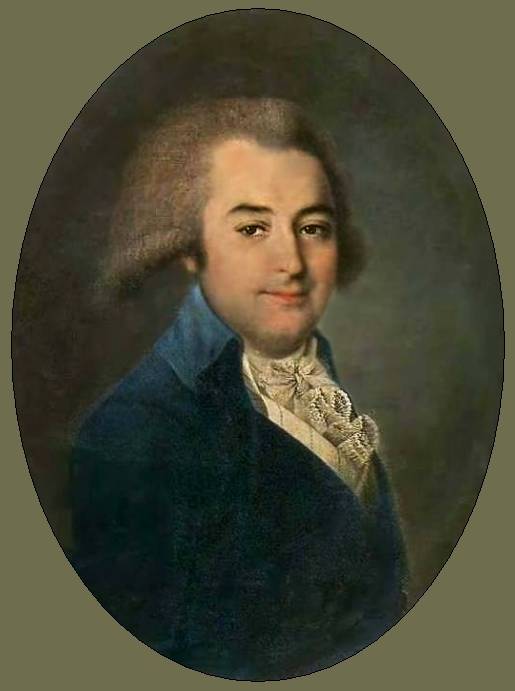

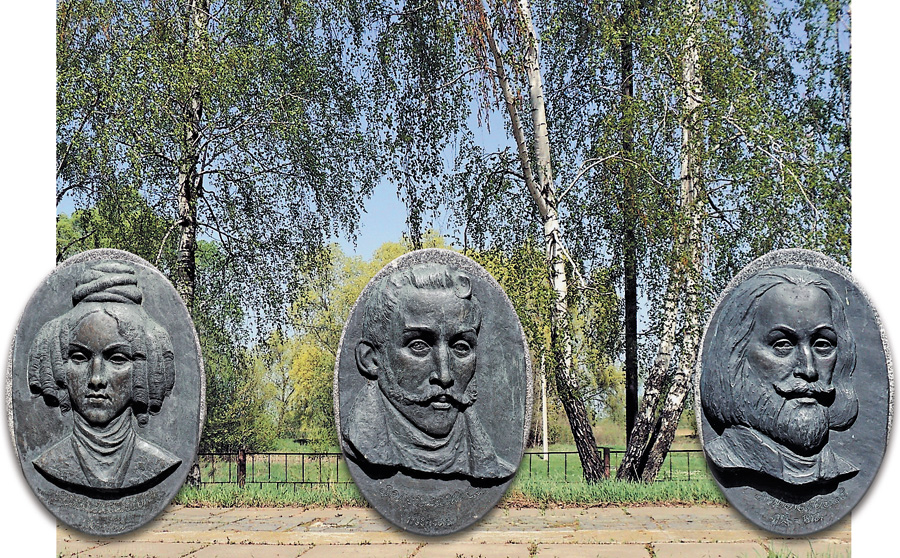
So in many regards, one could say that the estate came back into the Kotchoubey family again when it was purchased by Arkadi Vassilovitch. The land is characterized by vast plains punctuated by stands of pine trees and of course birch trees. The vegetation and fields are separated by the meandering Supoi river, and a number of smaller streams and beautiful lakes. Its historical significance today is largely due to the facts that the Kotchoubeys lived there and the fact that the Decembrist, Prince Sergei Grigorovich Volkonsky and his wife, Princess Maria Nikolaevna (née Raevskaya) and Alexander Poggio all died and were buried on the estate. The presence of the Decembrists was not haphazard as Nikolai Arkadievitch married secondly Elena Sergeievna (née Princess Volkonskaya) (1835-1916) and with whom he had one son, his heir, Mikail Nikolaivitch (1863-1935). Because Nikolai Arkadievitch died in 1865, the estate was run by his brother Piotr Arkadievitch and overseen by another noble local landowner Alexander Alexeivitch Rakhmanov (1830-1900?). Rakhmanov became an important figure in the family as he became stepfather to the estate’s owner as the third husband to Elena Sergeevna Kotchoubey.

Pictured above is a contemporary commemorative monument or cenotaph to the Decembrists and their fellow exiled Decembrist, Alexander Victorovitch Poggio (1798-1873) all of whom were buried on the estate at the time of their death and then interred in

a crypt in a new church in honour of St. John. The idea of building the church as a way of commemorating the Volkonskys and Alexander Poggio was a joint decision of Mikhail Nikolaivich and his mother, Elena Sergeievna. The church was designed by Alexander Eduard Yulievitch Yagn / Александр-Эдуард Юльевич Ягн (1848— 1922) who not only designed a number of estate houses and churches for the family but also became Elena Sergeievna’s fourth but common law husband. For church canonical reasons the marriage was in form only. The church itself which was built in 1904 and completed in 1905 in a neo Ukrainian renaissance revival style which was Yagn’s hallmark architectural style. At the consecration of the church in the autumn of 1905, thousands of people came from Kiev and Tchernigov. The church chorus from the local diocese to sing and among the singers was a young Pavlo Tichina/ Павло Тичина, who became a renowned Ukrainian poet and statesman. He created the lyrics to the Anthem of the Ukrainian Soviet Socialist Republic.
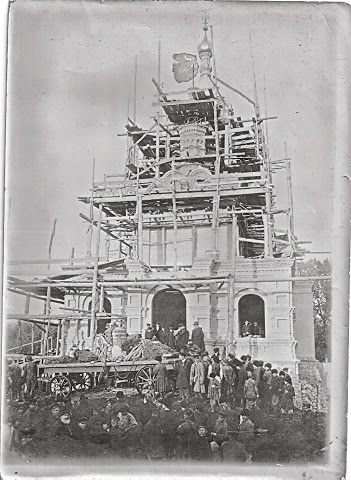
Yagn used the same style in the estate complex of Veisbokhovka which was located 30 km from Voronki and was commissioned by Elena Sergeievna and her third husband, Alexander Alexeivitch Rakhamanov. Within the church was built a family crypt where the Decembrists were laid to rest. The church, theatre and house were all destroyed or dismantled in the 20th century. According to local sources, the church was dismantled as per the decision of the local kolkhoz in the 1930s and the bricks were used in the construction of the local school.
Olga Dmitirievna Sidorowich (née Wickburg) whose mother was Elena Mikhailovna Wickburg (née Kotchoubey) to Kiev in the Soviet era and her friends in Kiev drove her the short distance to Voronki. She remembers that the local school house had a room with some old photographs and articles from the estate. Interestingly enough, a similar room exists in the 1950s era school house in Dubovichi which also has a room dedicated to the history of the Kotchoubey family and the village of Dubovichi. Olga’s visit was prior to the 1975 memorials to the Decembrists and upon her return to Canada, she told her cousins that the graves had been desecrated. In contrast to what Olga was told during her visit to her mother’s home in the Soviet period, the inhabitants today speak with pride at their history, the church that once stood in their village and the fact that the only Decembrists to be buried in Ukraine have been laid to rest in Voronki. According to a recent government article published in February 2016 (cited below), the doors of the iconostasis as well as numerous icons were saved from destruction by the locals at the time. It remains to be clarified if indeed the Decembrists were discretely reburied in the fields and protected from looting or unscrupulous communists looking to desecrate their graves.
The only remaining memorial to the Decembrists in Voronki today is a trilogy of memorial cenotaphs (Prince Sergei G. Volkonsky, his wife Princess Maria Nikolaivna (née Raevskaya) and their fellow Decembrist and friend Alexander Poggio). It was designed by the Soviet architect A.K. Stukalova / О. К. Стукалова and was built and placed in 1975 on the site of the original church.
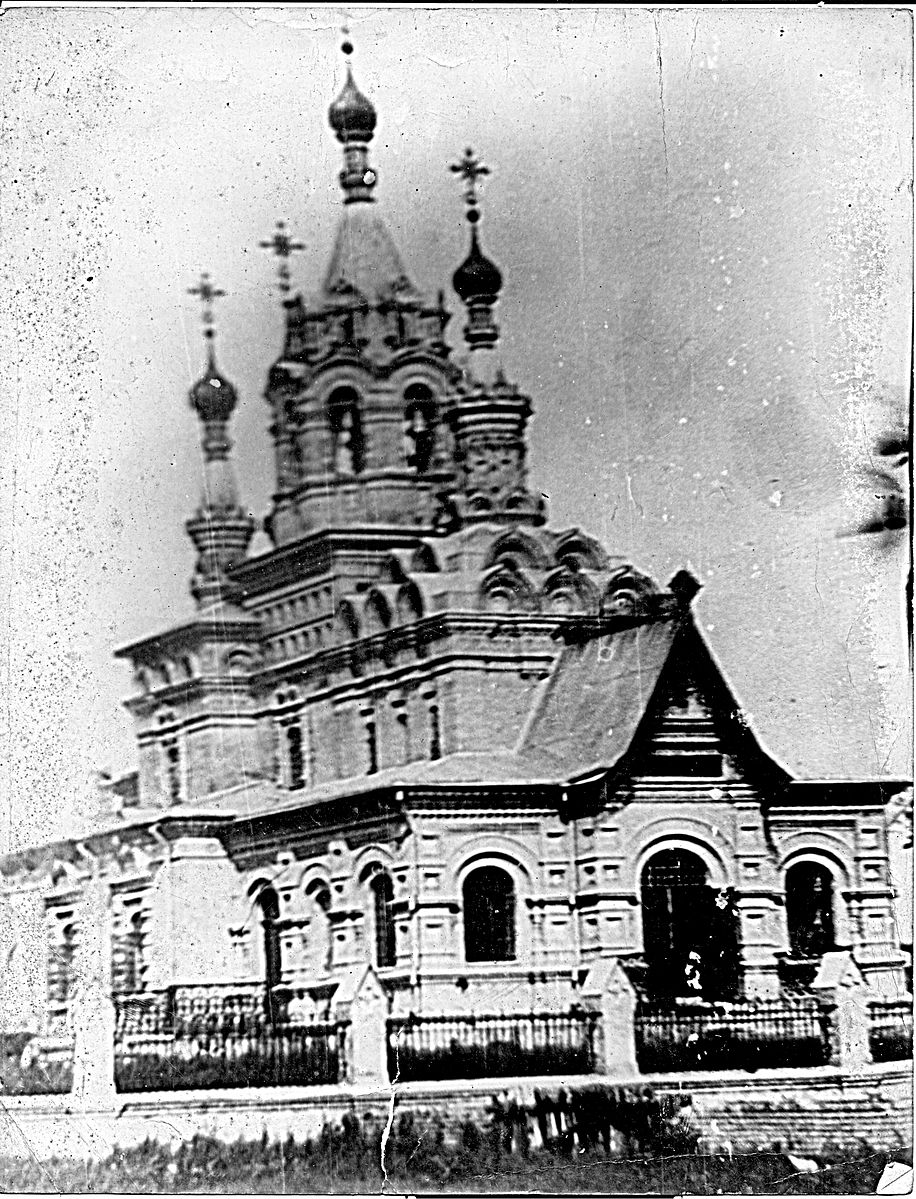
It should be also highlighted that the estate was also made famous by the presence of the Kotchoubey theatre which became one of the most renowned rural theatres in late 19th century Ukraine. It was started in 1861 by Maria Nikolaievna Volkonskaya (née Raevskaya) (1805-1863) when she arrived from exile in Irkutsk. Theatres on Russian estates were the cradle of Russia’s theatrical traditions and the Kotchoubeys were already known for their estate theatres going back to the 18th century. According to a recent Ukrainian government article (see: link), the actors in the theatre were from the Kotchoubey’s household staff, the local community and even members of the peasantary along with members of the family . The plays and operas that were known to be in the theatre’s repertoire included:
- “Natalia from Poltava”/ «Наталка Полтавка» (by Ivan Petrovitch Kotliarevskiy / Іван Петрович Котляревський
- “The Witch from Moscow” / «Москаль-чарівник»,
- “Unlucky”/ «Безталанна»,
- “Household”/ «Челядник»,
- “Nazar ‘Stodalia”/ «Назар Стодоля»
and a work by Nikolai Gogol, entitled, “The Fair at Sorochyntsi” which is the first of a number of short stories in the collection from Evenings on a Farm Near Dikanka /«Сорочинського ярмарку». Dikanka was yet another famous Kotchoubey estate owned by Prince Victor Sergeivich Kotschoubey at the time of the re-writing of Gogol’s story. The short story which was rewritten by Mikhail Nikolaivich was presented and published as a one act play called «Халепа». In the late 19th century Modest Petrovitch Mussorgsky / Модест Петрович Мусоргский (1839-1881) also wrote an unfinished opera based on this short story.
…Після 30 років заслання Волконські оселилися у селі Вороньки у маєтку зятя Миколи Кочубея та доньки Олени. Невгамовна Марія і тут знайшла вихід своїй кипучій енергії. Вона заснувала аматорський театр для народу. Для цього було зведене окреме приміщення, де, крім залу для глядачів, містилася бібліотека, більшість книжок якої належали Волконським. Грали в театрі здебільшого дворові люди, час від часу й селяни, а іноді й Михайло Миколайович (внук Волконських) та його сестра Лідія. У репертуарі були «Наталка Полтавка», «Москаль-чарівник», «Безталанна», «Челядник», «Назар Стодоля» тощо. Заради розширення репертуару Михайло Миколайович переробляв твори Миколи Гоголя, із «Сорочинського ярмарку», приміром, він сотворив п’єсу на одну дію «Халепа». (source: http://ukurier.gov.ua/uk/articles/nerozgadana-tayemnicya-zaliznoyi-dami/)
Along with many known actors, it was also a place where opera singers would come and sing and in fact one of the directors of the Kiev Opera after the Russian revolution got his start at the theater.
In Siberia, Maria Nikolaivna’s theatre in Irkutsk was also among the most renowned amateur theatres and by bringing these traditions west to Voronki she insured the survival of her theatre, well into the turn of the 20th century. Among the collection of family photographs which were gifted by the Florentine photographic studio, Foto Locchi to Sergei Mikhailovitch Kotchoubey (1896-1960) in the 1930s are photographs of two grandsons of Prince Sergei Grigorievitch Volkonsky, Mikhail Nikolaivich Kotchoubey and his first cousin Prince Sergei Mikhailovitch Volkonsky (1865-1938). While the photographs were taken in Florence in the 1880s, they reflect the love of theatre of their subjects. The costumes may have been chosen to reflect certain plays that had been performed in Voronki. Pr. Sergei Volkonsky who dressed as Mephistopheles in the photo below went on to become the director of the four Russian Imperial theatres. He also successfully convinced Tsar Nicholas II to hang again the portrait of his grandfather, Prince Sergei Grigorivitch in the Winter gallery of 1812 in the Hermitage. The portrait had been removed after his grandfather’s exile to Siberia in 1826.

Started by Maria Nikolaivna, the theatre was carried on by her daughter Elena Sergeievna after her death in 1863 and eventually by her grandson,

Mikhail Nikolaivitch Kotchoubey who was an actor and amateur playwright of some renown in local theatrical circles. One wonders if Prince Sergei Mikhailovitch Volkonsky’s love of theater was born in Voronki. While he never knew her, his grandmother was after all a guiding light through the theatre that she started and in this regard even after her early death she went onto influence Russian theatre.
Voronki or the river Supoi which runs through the estate is also the subject of a photograph taken by Mikhail Nikolaivich Kotchoubey which won him a prize as an amateur photographer and today this photo is kept at the Musée d’Orsay in Paris. It gives a view of the countryside and the rain drenched black earth on a bleak autumn afternoon.

In 1907, Mikhail Nikolaevitch Kotchoubey’s common law wife, Pelageia Dmitrievna Onoshko, although a local girl of middle class origins and with little formal education took out a mortgage on the estate in her own name. This became the last testament of the family’s love for the place as it had been driven into the hands of creditors by Mikhail Nikolaevitch who was seemingly unfazed by his wild spending and unpaid debts. After all he had just completed the church on his estate which was dedicated to his Volkonsky grandparents. He had long been moved by an independent spirit to leave the estate and his family and one supposes that his whereabouts were not known at the time. An estate, Kishnovka that had belonged to his great uncle Alexander Vassilievitch Kotchoubey and inherited by Mikhail Nikolaivich had been sold around this time and most likely in the aftermath of the terrible destruction wrought by the local population during the Revolution of 1905. Mikhail Nikolaivich had been Marshall of the nobility in the region of Kishnovka. In the end, he was perhaps generously described as a hopeless romantic and he may have already taken up with a local school teacher with whom he would leave Russia for the South of France in the ensuing years.
Given Mikhail Nikolaivich’s absence or disinterest, his common law wife, Peleagia Dmitirievna and their son-in-law, Dmitri Axelievitch Wickberg (married to Elena “Nelly” Mikhailovna,) took up the cause of returning the commercial operations of the estate back into the black. Returning from military school and in between their studies, the brothers three of his four sons, the brothers Vassili Mikhailovich Kotchoubey, Nikolai Mikhailovitch and Mikhail Mikhailovitch probably played a role in helping to run the estate in the years leading up to the Russian Revolution but both Nikolai and Vassili were serving as officers in the Russian Army during WWI so their input was not as marked. Largely thanks to Dmitri Axelievitch, whose Finno-Swedish family were in the Ukraine as managers of industrial estates (like Kharitenenko’s Sugar refineries) he and his mother-in-law were able to repay the mortgage by 1917 just as revolution swept across the country. By then, Mikhail Nikolaivich was in France and the Kotchoubey boys were beginning to prepare for the bloody Russian Civil War.
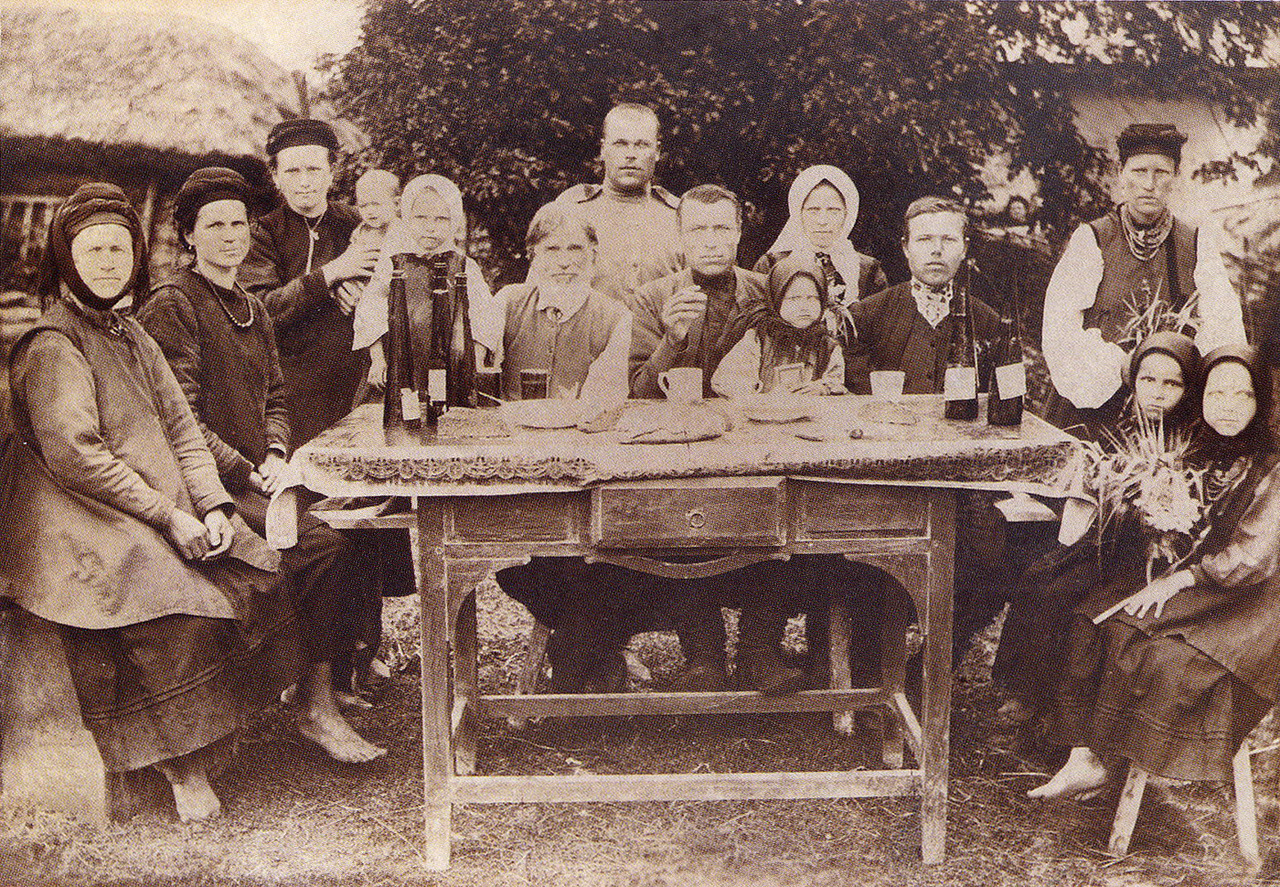
A postscript to the demise of the estate is that the legendary library of Mikhail Nikolaivich which would was comprised of literary books that he himself purchased and those owned by his grandmother the legendary, Maria Nikolaivna Volkonskaya as well as his parents remained fairly in tact even after the estate was turned into a collective farm after the Russian Civil War. However, the library disappeared after the German occupation and the German retreat in 1943
- source: https://ru.wikipedia.org/wiki/Вороньки_(Черниговская_область)
